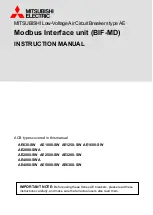
6. Blown Limiter Indicator (Refer to Paragraph 3-2 and Figure
4-16)
4-5 Mechanical Interlocking System Description
WARNING
DO NOT TAMPER WITH THE INTERLOCkING SYSTEM. IF ANY
PART OF THE SYSTEM IS NOT FUNCTIONING CORRECTLY, HAVE
IT CORRECTED IMMEDIATELY. INTERLOCkING THAT IS NOT
FUNCTIONING PROPERLY COULD RESULT IN MECHANICAL AND
ELECTRICAL EQUIPMENT DAMAGE, SERIOUS BODILY INJURY
AND/OR DEATH.
To increase safety to personnel and the circuits to which the
breaker is connected, the complete unit is equipped with an
automatic mechanical interlocking system. This interlocking
system is effective in various ways in the four breaker posi-
tions: REMOVE, DISCONNECT, TEST and CONNECT (Figure
4-10 ) .
In addition, there is an interference interlock described in
Paragraph 3-11.1 used to prevent the insertion of a circuit
breaker into a non-compatible compartment.
The mechanical interlock system serves basic and distinctive
purposes in each of the four breaker positions. The follow-
ing information describes the interlocking conditions which
exist in each of the positions. The shutter referred to in these
detailed explanations is the device which covers access to
the levering device worm shaft on the front of the breaker
(Figure 3-3).
4-5.1 REMOVE Position
In the REMOVE position, the breaker is nearest to the front
of the compartment. It is also where the breaker must be
placed when being installed, after having been completely
outside the compartment.
In this position, the following conditions exist:
1. The breaker is open.
2. The closing springs are discharged. If an attempt is made
to charge the springs, a trip-free operation will result.
3. The breaker cannot be closed electrically or manually.
4. The breaker can be withdrawn from the compartment by
direct pull. The levering device is not engaged with the
cradle at this point.
5. The levering device arms are in a horizontal position with
their rollers pointing toward the rear (Figure 2-4).
4-5.2 DISCONNECT Position
In the DISCONNECT position, the breaker has moved only
a fraction of an inch into its compartment. This position is
indicated by the position indicator on the front of the breaker
(Figure 3-3).
In this position, the following conditions exist:
1. The breaker is held in its compartment, since the levering
rollers lowered into the slots in the compartment’s cradle
arms.
2. The shutter closes over the levering device hex shaft.
3. The shutter may be locked closed and the breaker held
trip-free with a padlock, thus locking it in its compartment.
Padlocking provisions are described later in this section.
4. Both primary and secondary disconnect contacts are
separated.
5. The breaker is open.
4-5.3 TEST Position
In the TEST position, the breaker is at a point that is in be-
tween the DISCONNECT and CONNECT positions, as indi-
cated the drawout position indicator. The main disconnecting
contacts are sufficiently separated to permit safe operation
of the breaker. The secondary contacts are now made up.
In this position, the following conditions exist:
1. The breaker arrives in this position, whether being in-
serted or withdrawn, with its contacts open. Its closing
springs can be either charged or discharged when coming
from the CONNECTED position.
2. After the levering crank is removed, it is possible to close
and trip the breaker both manually and electrically.
3. Just before the breaker arrives in the TEST position from
the DISCONNECT position, the secondary contacts make
up and the spring-charge motor on power
Effective July 2010
Instructional Book
IB694C694-03
40
eaton corporation
www.eaton.com













































